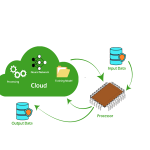
Designing for the Future: How AI is Shaping Responsive Frameworks
- Post
- August 8, 2023
- Mobile & Responsive, Responsive Frameworks, Web Design
- 0 Comments
In today’s rapidly evolving digital landscape, where user experience reigns supreme, responsive web design has become a cornerstone for success. The ever-expanding array of devices and screen sizes requires adaptable frameworks that can seamlessly adjust to diverse contexts. Enter the marriage of artificial intelligence (AI) and responsive frameworks – a blend that’s revolutionizing the way websites are built and experienced. In this comprehensive exploration, we delve into the profound impact AI is having on responsive web design frameworks, bringing to light the intersection of cutting-edge technology and user-centric design.
The Rise of Responsive Frameworks
Before we plunge into the realm of AI, let’s take a moment to revisit the essence of responsive frameworks. In a world where users engage with websites on everything from smartphones and tablets to desktops and smart TVs, the need for fluid, adaptable designs is paramount. Responsive frameworks lay the foundation for websites to seamlessly scale and reshape themselves based on the user’s device, screen size, and orientation. This ensures that content remains visually appealing and functional across the entire spectrum of devices.
AI’s Entry into the Arena
Now, picture AI stepping onto this stage with its arsenal of machine learning algorithms, data analysis prowess, and predictive capabilities. AI-powered responsive frameworks can analyze user behavior, device specifications, and contextual cues to make real-time decisions about how a website should be presented. This dynamic adaptation goes beyond mere responsive design – it’s about predictive design, where AI anticipates user needs and optimizes the experience proactively.
The Power of Personalization
One of the most striking impacts of AI on responsive frameworks is personalization. AI algorithms can analyze user preferences, browsing history, and interactions to create highly tailored experiences. Imagine a website that knows whether a visitor is a first-time user or a loyal customer, and then adjusts its layout, content, and recommendations accordingly. This level of personalization not only enhances user engagement but also drives conversions and brand loyalty.
Streamlined Development with AI
Traditionally, developing responsive websites demanded meticulous coding and testing to ensure consistency across devices. Enter AI, which is simplifying this process by automating aspects of development. AI-powered tools can generate responsive code, identify potential design inconsistencies, and even suggest improvements based on industry best practices. This not only expedites development but also elevates the overall quality of the end product.
AI’s Role in Performance Optimization
Page load speed is a critical factor in user satisfaction and SEO rankings. AI-enhanced responsive frameworks can optimize image sizes, load priority content first, and employ browser caching strategies – all of which contribute to faster load times. By leveraging AI’s data-driven insights, websites can deliver exceptional performance tailored to each user’s unique context.
The Marriage of AI and Aesthetics
Aesthetics play a pivotal role in user engagement and brand perception. AI is now venturing into the realm of design aesthetics, analyzing color schemes, typography, and layout preferences to create visually captivating experiences. This fusion of data-driven insights and creative design principles promises to reshape the way websites are visually presented.
Ethical Considerations and the Human Touch
While AI’s influence on responsive frameworks is groundbreaking, ethical considerations must be at the forefront of this evolution. Balancing automation with the human touch is essential. AI can aid in decision-making, but it’s the human designer who imbues websites with emotional resonance and cultural sensitivity. Striking this balance ensures that technology serves as a tool, not a replacement, for human creativity.
Final Words
The convergence of AI and responsive frameworks marks a pivotal moment in web design history. As we step into this era, we witness the evolution of technology that not only caters to user needs but anticipates them. The synergy of AI’s analytical prowess and human creativity promises a digital landscape where websites aren’t just responsive – they’re intuitive, personalized, and exquisitely designed. Embracing this transformation will allow us to unlock the full potential of web experiences in the dynamic landscape of the future.
Commonly Asked Questions
Q1. How does AI enhance responsive web design frameworks?
AI empowers responsive frameworks to adapt to user behavior, personalize experiences, streamline development, optimize performance, and even contribute to design aesthetics.
Q2. Can AI completely replace human designers in web development?
No, AI complements human designers by automating certain tasks and providing data-driven insights, but the human touch in design and creativity remains invaluable.
Q3. Is personalization through AI a privacy concern?
Personalization relies on user data, raising privacy concerns. Responsible AI implementation involves transparent data usage and robust privacy measures.
Q4. How do AI-powered frameworks improve SEO?
AI optimizes websites for performance, which is a crucial factor in SEO rankings. Faster load times, adaptive content, and user-centered experiences all contribute to improved SEO.
Q5. What’s the future of AI and responsive frameworks?
The future holds the promise of even more sophisticated AI-powered frameworks, seamlessly blending AI’s predictive capabilities with human creativity for unparalleled digital experiences.




